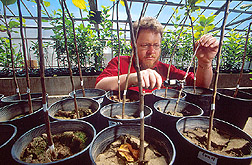This page has been archived and is being provided for reference purposes only. The page is no longer being updated, and therefore, links on the page may be invalid.
|
|
Beneficial Bacteria Help Thwart Apple DiseaseBy Jan SuszkiwAugust 14, 2002 Instead of chemical fumigants, beneficial bacteria may be called on to fight fungi that cause replant disease, so-named because it strikes young apple trees planted in old orchards. The Pseudomonas putida bacteria are part of a “bio-rational” approach now being field tested by plant pathologist Mark Mazzola, with the Agricultural Research Service’s Tree Fruit Research Laboratory in Wenatchee, Wash., and David Granatstein, director of Washington State University’s Center for Sustaining Agriculture and Natural Resources at Wenatchee. In Washington state, where half the U.S. apple crop is grown, replant disease is primarily caused by certain species of Pythium, Rhizoctonia, Cylindrocarpon and Phytophthora fungi. Unchecked, they can diminish a grower’s crop returns by $40,000 per acre over 10 years, an orchard’s average production life. Marketing demands often force growers to replant old orchards with new varieties sooner than they might like. Fumigating orchards with chemicals like methyl bromide offers a fast, effective way of sterilizing soils before planting time. But methyl bromide is expensive to use, and will be prohibited in 2005. P. putida bacteria offer an appealing alternative because they often occur naturally around apple roots and secrete antibiotics that check infection by Rhizoctonia fungi. Mazzola, who identified the bacteria, doesn’t apply them, so much as augment their populations in orchards. This is done by planting a cover crop of certain soft white wheat cultivars whose root secretions create a favorable soil environment. In a 2001 trial with Gala apples, this resulted in fruit yields of about 46 pounds per tree versus 60 pounds where methyl bromide treatments were used. Field tests begun this May may show whether applying dried rapeseed meal after the wheat crop can synergize, or improve, the bacteria’s biocontrol performance. Apple orchards often harbor many different replant disease fungi. So the Wenatchee researchers are testing other bio-rational approaches as well. These include using various cultural practices--planting trees in drive aisles rather than rows, for example-- fungicides, and hardier apple rootstocks. ARS, the U.S. Department of Agriculture's main scientific research agency, has patented the beneficial bacteria. |

